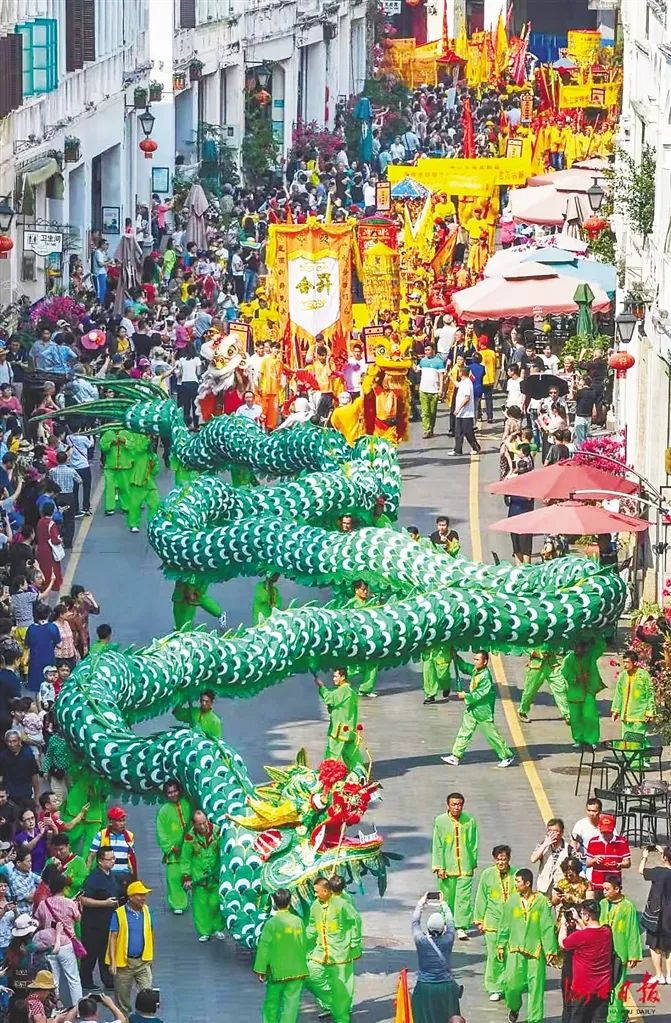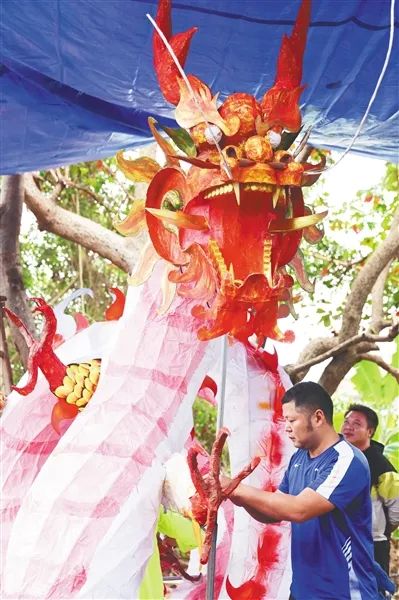By continuing to browser our site and use the services you agree to our use of cookies, Privacy Policy and Terms of Use. You can change your cookie settings through your browser.
Dragon dances have been an important part of China’s culture since the Shang and Zhou dynasty periods, when they developed as a method to beseech the heavens for good weather, fortune, and health. In Hainan, dragon dances have also long been performed during holidays and festivals in villages, towns, and cities across the island province. Spring Festival is an especially popular time for this particular custom, so keep an eye out for flashing scales and long, sinuous tails. Acrobatic leaps and twirls are accompanied by the cheerful banging of drums and gongs, bringing cheer, good luck, and hope for the new year to all who are fortunate enough to witness the joyous dance of dragons.
So many colorful dragons
As you enter Pozu Temple in the Ximen district of Wancheng Town, Wanning, you’ll discover a giant, 60 meter long dragon dominating the space. This is the green dragon, one half of a traditional matched set in Wanning, one red, one green. Local legends circulating since the Ming dynasty period tell of the arrival of these two dragons in Wanning. The first is the green dragon of Ximeng, a slightly larger male, and the second is the slightly smaller female red dragon of Binwang Village. To this day, the dragon dances of these two places are known as the most vibrant in the land.
In Zhonghe Town, Danzhou, dragons come in even more fantastical shapes and colors. There are fire dragons as red as flickering flames, golden dragons with scales like shining treasure, and even odd looking hybrids with dragon heads and shrimp bodies. Each dragon comes to life with flashing eyes and wise expressions. As Lantern Festival approaches, locals prepare to stage different dragon dances in each of Zhonghe Town’s eight districts.

Hand-crafted dragons
Making a dancing dragon is not simple! The interior of each dragon is composed of a lattice of interwoven strips of bamboo. These thin strips must be made from high-quality, tough, straight pieces of bamboo that must be carefully split and dried before becoming the innards of a dragon. The dragon’s head and tail are the most complicated parts of the beast, and each require highly skilled craftsmanship to bring them to life.
The head of the dancing dragon, for example, requires five or six pieces of bamboo to make. Strips of bamboo must be individually heated until they become pliable, and can be shaped into the dragon’s whiskers, nose, ears, mouth, eyes, and horns. The process of creating the head alone takes around 20 days, and involves tying over 200 knots. The entire body of the dragon requires around 4,000 bamboo strips and over 4,000 individual knots. In Zhonghe Town, Danzhou, they have a slightly different way of making the dragon heads. Here, the shape of the head is roughed out in clay, then refined with strips of paper adhered with sticky rice paste. The dragon head is dried in the sun, and then the clay is removed, leaving the paper shell, similar to the technique of Papier-mâché. The paper dragon head is then painted with bright, eye-catching colors. Dragon heads made in this way are much more mobile and lightweight, making them easy for the dragon dancer to manipulate.

Leaping dragons
In Wanning, after a new dragon has been made, it must be taken to the river for a dedication ceremony of the day of Laba Festival. The dragon dancers perform with the new dragon in deference to the local gods all along the way, accompanied by a cacophony of drums, gongs, and firecrackers. On the fifteenth day of the new year, the dragon dancers, along with the lion dancers, qilin dancers, stilt-walkers, flower drum team, floats, lanterns, and more merry-makers set out together to celebrate Lantern Festival. The dragons leap and crouch, fly fast and creep along, performing daring acrobatic feats that thrill and surprise the gathered audience members. Adults and children alike compete to dash under the of the dragon and touch the belly of the beast for good luck. Children also dart up to touch the dragon’s neck, which is said to keep them safe from illness in the coming year. Sometimes, red envelopes are hung from third and fourth floor roofs. The dragon dancers must work together to stand on each other in a tower reaching over 10 meters in height to snatch the red envelopes, which symbolize good fortune.
Dragon dancing is not easy. Each of the twenty sections of the dragon’s body requires one dancer to control it, and the head alone often weighs over 30 kg. After only 20 minutes of energetic, acrobatic dancing, the team is dripping in sweat and takes a well deserved break. Although dragon dancing is exhausting, the honor of participating in this ancient, beloved tradition brings a glow of pride to each dancer’s heart, and ensures that there will always be new dancers ready and willing to embody the wild, beating heart of the dragon.
ASEAN Media Visit Qionghai Tropical Auto Test Track
11:51, 27-August-2025Sanya’s West Island: From Fishing Village to Zero-Waste Model
11:10, 27-August-2025BiUH Welcomes the Class of 2025 in Hainan
11:10, 27-August-2025Hainan FTP Extends Corporate Income Tax Incentives till 2027
04:40, 24-August-2025Li Yuemei: the “Mulan” of Nanqiao Jigong
04:37, 24-August-2025Discovering Mysteries Season 5, Episode 12: Love Ballad of the Rainforest Frog
05:26, 22-August-2025By continuing to browser our site and use the services you agree to our use of cookies, Privacy Policy and Terms of Use. You can change your cookie settings through your browser.





